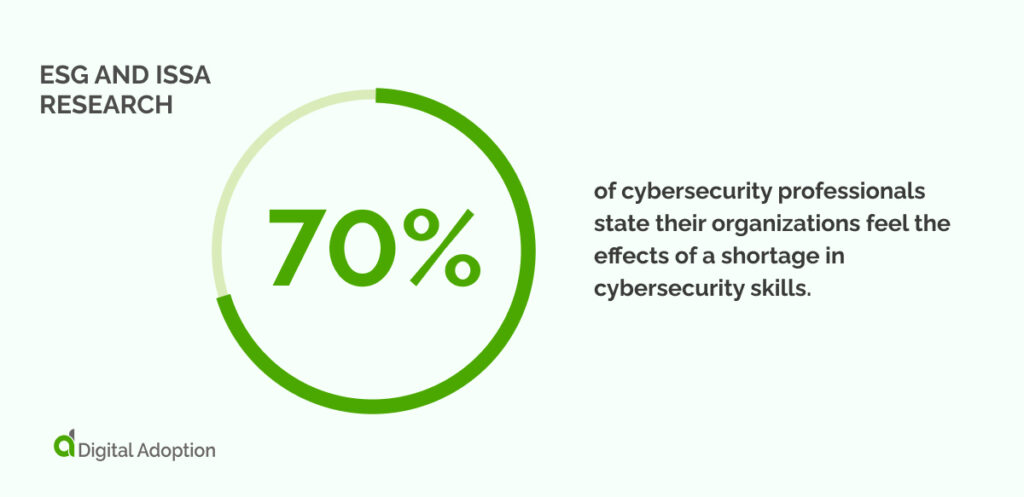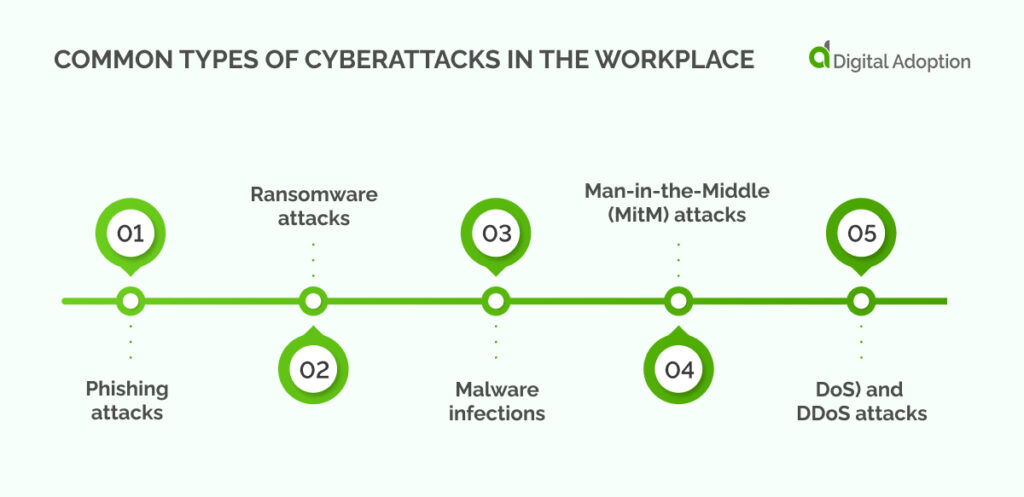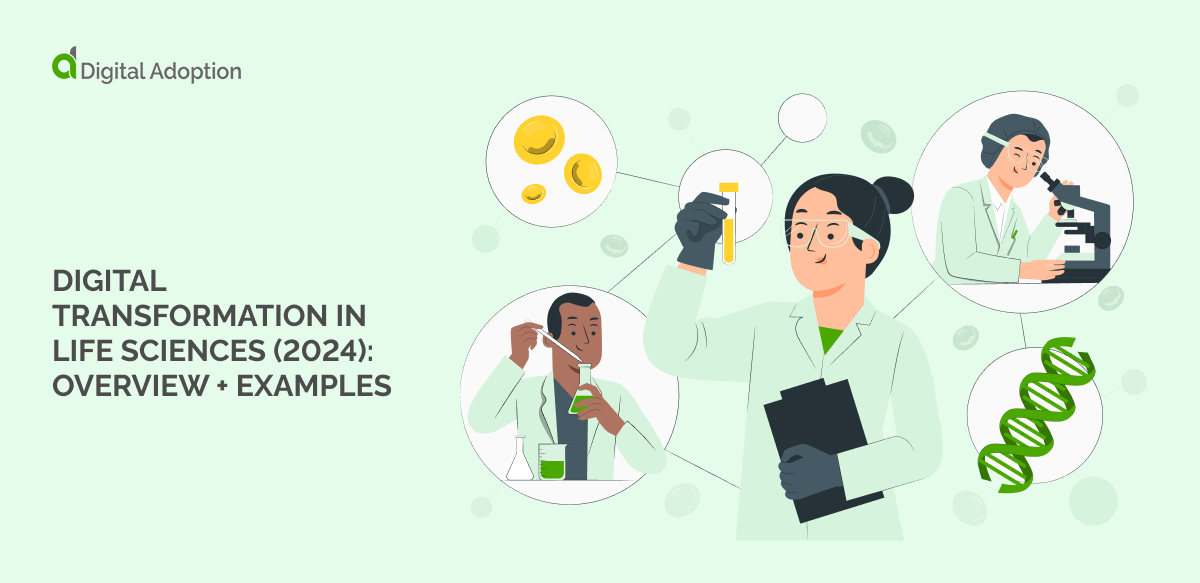Adopting a strong stance on cybersecurity is an easy decision for today’s business leaders tasked with protecting mission-critical systems from the many threat actors just beyond their scope.
Those at the helm of IT face the brunt of this challenge, with reports from IBM showing that the worldwide average data breach cost rose to USD 4.45 million, marking a 15% increase over three years. Notably, 51% of respondents intend to boost security investments in response to such breaches.
A lack of preemptive measures for mitigating cyber threats can cause a host of negative effects for today’s organizations. This includes data theft, breaches in privacy, regulatory and compliance issues, financial loss, disruptions to critical systems, and irrevocable reputational harm.
This article will highlight the necessity of agile cybersecurity practices for safeguarding data, mitigating attacks, and strategizing a workplace culture ingrained in trust.
- What is cybersecurity in the workplace?
- Why is cybersecurity in the workplace important?
- What are the top cybersecurity risks?
- Common types of cyberattacks in the workplace
- How to mitigate cyberattacks in the workplace
- Tips for building a cybersecurity-focused workplace culture
- Cybersecurity in the workplace: A prerequisite for security and innovation
What is cybersecurity in the workplace?
Cybersecurity in the workplace describes cultivating a working environment in which end-to-end cybersecurity practices are prioritized and ingrained into all aspects of company culture.
It’s a proactive approach that aims to embed cybersecurity into a company’s ethos, making it an integral part of its identity and operations.
This includes adopting watertight IT security measures around, ensuring regular employee training on handling cyber threats, collaborating closely with HR for workforce awareness, and implementing advanced technologies to safeguard proprietary data.
However, ESG and ISSA research findings show that 70% of cybersecurity professionals state their organizations feel the effects of a shortage in cybersecurity skills.

Responsibility for addressing these challenges falls not only on the CISO but on EVERY member of the organization. Joint participation must be made to defend against potential cyber risks, ensuring the organization’s confidentiality, integrity, and availability of crucial information.
Why is cybersecurity in the workplace important?
The digital transformation era has seen modern firms leverage the latest tech solutions for re-configuring business models, tailoring their tech portfolios, and underpinning a myriad of key business functions.
However, a business’s strength is ultimately determined by its most vulnerable aspect. Despite having a sophisticated cybersecurity system, it’s typically human error and carelessness that gives cybercriminals the greatest chance to infiltrate systems and inflict damage.
The widespread use of and reliance on technology, from computers, laptops, smartphones, and the Internet of Things (IoT), provide cybercriminals with various potential attack points.
Businesses manage extensive volumes of crucial data, encompassing personally identifiable information for employees and customers. They also handle authentication data, safeguarding credentials and permissions, financial data linked to transactions, intellectual property housing proprietary patents, and operational data vital for sustaining day-to-day functions.
A substantial portion of this data pertains to third parties—customers, suppliers, and business partners. This presents an elevated risk factor for organizations, making them more of a target for malicious activities by threat actors.
While a simple internet connection serves as a key conduit for threat actors to exploit vulnerabilities in an enterprise network, not all cyber threats require an internet connection. Some attacks can be initiated through other attack vectors, such as physical access, infected devices, or insider threats.
Additionally, AAG reports that the pandemic impacted cybersecurity, prompting businesses to swiftly transition employees to remote work environments. This led cybercriminals to exploit network misalignments and security gaps, culminating in a 358% surge in malware attacks in 2020 compared to 2019.
With threat actors having an array of attack vectors at their disposal, including exploiting an organization’s heightened tech investments, evolving work models, and handling critical data, advocating comprehensive cybersecurity practices throughout the organization can not be overstated.
What are the top cybersecurity risks?
According to a 2022 gov.uk survey, phishing stands out as the most prevalent form of breach or attack reported among organizations in the last 12 months. This involves staff receiving deceptive emails or being directed to fake websites.
The survey also shares: “One of the consistent lessons across this series of surveys has been the importance of staff vigilance, given that most cyber actors use social engineering techniques to gain access to the target organization’s networks.”
Cybersecurity should be a top priority for CIOs due to its critical role in safeguarding sensitive data, maintaining operational continuity, and preserving organizational reputation in the face of evolving cyber threats.
82% of confirmed data breaches against organizations involved the human element, according to new cybersecurity data uncovered by the 2023 Data Breach Investigations Report.
With this in mind, let’s identify the most pertinent causes that compound cybersecurity risks, exploring the various elements that can compromise the digital defenses of individuals and organizations alike:
- Weak credentials and passwords: Inadequate password strength and easy-to-guess credentials create vulnerabilities, providing a potential entry point for unauthorized access.
- Opening dodgy emails: Clicking suspicious links or downloading attachments from unverified sources can introduce malware and compromise the system’s security.
- Oversharing on social networks: Revealing sensitive information on social platforms increases the risk of social engineering attacks, where attackers exploit personal data for unauthorized access.
- Using unsanctioned devices: Accessing company data on personal or unsecured devices, especially with the increasing trend of Bring Your Own Device (BYOD) to work, heightens cybersecurity risks. This practice exposes critical information to potential breaches and compromises, emphasizing the need for stringent security measures—especially in the era of remote work.
- Access through outdated software: Using outdated software increases susceptibility to known vulnerabilities that threat actors can exploit, highlighting the importance of software patches and regular updates.
- Lack of awareness around cyber-safety: Insufficient education and awareness about potential cyber threats make employees more susceptible to unintentional security lapses.
- Remaining vigilant: Cultivating a culture of vigilance involves staying informed, promptly addressing security issues, and encouraging proactive measures to mitigate evolving cybersecurity risks.
Common types of cyberattacks in the workplace

Understanding the most common types of cybersecurity attacks is crucial for businesses to protect their data, operations, and reputation.
Recognizing prevalent threats like phishing and malware enables businesses to implement effective security measures, educate employees, and establish robust incident response plans to mitigate risks and maintain trust with customers and stakeholders.
Let’s explore further:
Phishing attacks
Phishing is a deceitful tactic where cybercriminals craft seemingly legitimate emails or messages to trick individuals into divulging sensitive information.
These communications often mimic trusted entities like banks or online services, urging recipients to click on malicious links or download harmful attachments. Despite advancements in email filtering and user awareness, phishing remains a prevalent threat, exploiting human vulnerability.
Vigilance and education are paramount to recognizing and thwarting such attacks, as they can lead to data breaches, financial losses, and compromised systems.
Ransomware attacks
Ransomware is a menacing malware that encrypts files on victims’ devices or networks, rendering them inaccessible until a ransom is paid. This malicious software can propagate rapidly across systems, exploiting vulnerabilities in software or leveraging social engineering tactics to infiltrate networks.
Ransom demands, typically in cryptocurrency, accompany the attack, leaving victims with a dire choice: pay up or risk permanent data loss.
Businesses and individuals face substantial risks from ransomware attacks, necessitating robust cybersecurity measures, regular data backups, and comprehensive incident response plans to mitigate the impact and prevent future occurrences.
Malware infections
Malware, a broad category encompassing various forms of malicious software, poses a significant threat to computer systems and networks worldwide.
From viruses and worms to Trojans and spyware, malware can infiltrate devices through infected files, compromised websites, or deceptive email attachments. Once installed, malware can execute various harmful activities, including data theft, system corruption, and unauthorized access.
Defending against malware requires a multi-layered approach, incorporating antivirus software, regular system updates, user education, and cautious online behavior. Despite these defenses, the ever-evolving nature of malware demands constant vigilance and adaptation to emerging threats.
Man-in-the-Middle (MitM) attacks
Man-in-the-Middle (MitM) attacks exploit vulnerabilities in communication channels to intercept and manipulate data exchanged between parties without their knowledge. Inserting themselves into the communication flow allows attackers to eavesdrop on sensitive information or alter messages to serve their nefarious purposes.
MitM attacks can occur in various contexts, including unsecured Wi-Fi networks, compromised routers, or hostile software installed on devices. To mitigate the risk of MitM attacks, organizations and individuals should employ encryption protocols, utilize secure communication channels, and remain vigilant for signs of tampering or unauthorized interception.
Denial-of-Service (DoS) and Distributed Denial-of-Service (DDoS) attacks
Denial-of-Service (DoS) and Distributed Denial-of-Service (DDoS) attacks aim to disrupt the availability of online services by overwhelming them with an excessive volume of traffic or requests. In a DoS attack, a single source floods the target with traffic, while a DDoS attack employs multiple distributed sources, often coordinated through botnets.
These attacks can result in service downtime, financial losses, and damage to an organization’s reputation. Defending against DoS and DDoS attacks requires robust network infrastructure, traffic monitoring systems, and rapid response capabilities to mitigate the impact and restore service availability.
How to mitigate cyberattacks in the workplace
Mitigating cyberattacks and upholding a strong security posture across the organization is easier said than done.
Navigating a sea of changes, whether staying atop the latest in innovative tech, adjusting to new working norms in a post-pandemic world, or adapting to changing customer expectations, brings a host of challenges even the most strategic organization cannot predict.
Any transition in which processes, people, or technologies transform will create vulnerabilities for threat actors to target.
These periods of change, characterized by adjustments and uncertainties, become ripe opportunities for cyber attackers to exploit gaps, emphasizing the need for heightened cybersecurity measures during such transformative phases.
Tessian’s Psychology of Human Error report reveals that a quarter of respondents admitted falling for phishing scams. Distraction emerged as the leading cause, noted by 47% of participants, and a substantial 57% claimed increased distraction while working from home.
As such, mitigating cyber threats involves integrating the following practices into your digital routine:
- Stay vigilant for any unusual activity, promptly reporting it through an incident reporting protocol for swift resolution.
- Maintain robust password management, ensuring digital credentials are regularly updated for heightened security.
- Enhance account security with multi-factor authentication (MFA), adding an extra layer of protection to your digital identity.
- Keep access information confidential, treating it with the utmost privacy to prevent unauthorized entry. Enable auto-lock on your devices and refrain from leaving them unsupervised.
- Exercise caution with digital correspondence, sticking to emails and attachments from known and trusted sources to avoid potential cyber threats.
- Navigate the digital spaces responsibly using authorized software and hardware, avoiding personal installations to maintain the overall network integrity.
- Keep your digital environment up-to-date by promptly addressing outdated software and minimizing potential vulnerabilities.
- Safeguard your digital work by making regular backups of company data, ensuring a quick recovery in case of any security incidents.
- Secure your online presence, especially when working remotely, by fortifying your internet connection through measures like virtual private networks (VPNs) and encrypted communication channels.
Tips for building a cybersecurity-focused workplace culture
Creating a workplace cybersecurity culture is essential for promoting awareness, reducing vulnerabilities, and ensuring the resilience of organizational systems against cyber threats.
Most businesses recognize that a robust cybersecurity culture protects their interests and enhances their reputation and credibility in the eyes of clients and partners.
However, implementing and sustaining such a culture requires ongoing education, regular training, and clear communication of policies and procedures to ensure that every employee understands their role in maintaining a secure work environment.
Let’s explore some vital tips for building a cybersecurity-focused workplace culture:
Develop a comprehensive security strategy
Developing a comprehensive cybersecurity strategy is imperative to ensure security is thoroughly embedded into company culture at every level, and preparations have been made to thwart an array of potential threats.
This strategic framework establishes robust technical defenses, which in turn helps to cultivate a cybersecurity-conscious culture.
Implementing a cybersecurity strategy assists leaders in promoting awareness, education, and shared responsibility for data protection. This will help build a resilient and vigilant workforce that prioritizes security in a structured and systematic way.
Prioritize a learning culture
Prioritizing the cultivation of a culture of education around cybersecurity is the bread and butter of good practices. The overall risk landscape diminishes when users know how to recognize and mitigate threats properly.
Regular training sessions covering phishing awareness, secure password practices, incident response protocols, and ongoing communication channels within the cybersecurity strategy provide employees with practical skills and knowledge.
This empowers them to actively contribute to the organization’s defense against evolving cyber threats, turning education into a tangible solution for bolstering cybersecurity within the workplace.
Promote awareness
Effective communication is crucial for fostering a cybersecurity-aware workplace culture. To achieve this, disseminate information on cyber threats, preventive measures, and reporting protocols through newsletters, posters, and emails. Encourage open dialogue, enabling employees to freely express security concerns or queries.
A collaborative environment emerges by promoting awareness and transparency, wherein each individual actively contributes to safeguarding the organization. This approach enhances security measures and instills a sense of collective responsibility among the workforce.
Educate continuously
Ensure your team remains sharp by organizing regular cybersecurity training sessions. These sessions are crucial for equipping everyone with the latest knowledge of cyber threats and best practices to mitigate them. Investing in ongoing education empowers employees to stay vigilant and proactive in safeguarding company assets and data.
Fostering a culture of continuous learning and preparedness within your organization is a cornerstone for enhancing resilience against the ever-evolving landscape of cybersecurity challenges.
Encourage collaboration
Cybersecurity demands collective vigilance, necessitating a team effort. Cultivate a collaborative culture where employees can share insights, report suspicious activities, and participate in security initiatives.
Breaking down silos and promoting teamwork bolsters your organization’s security posture, enhancing resilience against cyber threats. Emphasize the importance of shared responsibility and active participation in safeguarding digital assets to fortify defenses and mitigate risks effectively.
Lead by example
Leadership plays a pivotal role in shaping the cybersecurity culture within an organization. When executives and managers prioritize security measures, it sends a resounding message across the organization.
Their commitment to cybersecurity principles instills trust and motivates employees to adhere to best practices. Fostering a culture where security is embedded in every facet of operations establishes a strong foundation for protecting sensitive information and mitigating cyber risks effectively, showcasing leadership’s commitment to cybersecurity principles.
Incentivize compliance
Acknowledge and incentivize exemplary cybersecurity behavior to cultivate positive habits and ensure compliance with security protocols. Establish incentive programs that recognize employees for their vigilance, whether by reporting phishing attempts or adhering to password policies.
Offering tangible rewards and recognition emphasizes the importance of cybersecurity within the organization, fostering a culture where it is valued and prioritized. Such incentives serve as potent motivators, encouraging active participation in safeguarding sensitive information and upholding security standards.
Cybersecurity in the workplace: A prerequisite for security and innovation
According to a Deep Instinct and Sapio Research study, 75% of security professionals noted an increase in cyber attacks over the past year, and 85% attribute this surge to malicious actors employing generative AI.
These statistics underscore the significant impact of cyber threats on organizations, indicating a concerning rise in attacks.
Moreover, cybersecurity is the foundation upon which businesses can innovate confidently and with agility. Organizations prioritizing robust security measures create a safe environment conducive to experimentation and advancement.
With a solid cybersecurity framework in place, businesses can explore new technologies, embrace digital transformation initiatives, and develop innovative products and services without compromising data integrity or risking exposure to cyber threats.
With that in mind, it’s evident that businesses must remain vigilant and continually adapt their cybersecurity strategies to mitigate the evolving threat terrain. But it’s easier said than done, as navigating the complexities of cybersecurity requires a comprehensive approach encompassing technology, education, and proactive risk management strategies.
Customers expect businesses to prioritize cybersecurity measures, safeguard sensitive data, and ensure a secure online experience to maintain trust and loyalty. So, this should be the focus for all organizations striving to uphold their integrity, protect their stakeholders, and sustain long-term success in an increasingly digital world.













